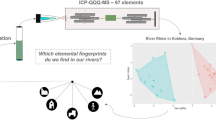Abstract
A new scheme for determining the destruction of organic matter in bottom sediments with an account of methanogenesis and the dark assimilation of CO2 is suggested. The values of the total destruction calculated according to the new methodical scheme increases by 30–60%.
Similar content being viewed by others
References
Dzyuban, A.N., Opredelenie Determination of decomposition of organic matter in bottom sediments of water bodies, Gidrobiol. Zh., 1977, vol. 23, no. 2.
Dzyuban, A.N., Microbiological Processes of Organic Matter Turnover in Deposits of the Volga-Kama Chain of Reservoirs, Water Resour., 1999, vol. 26, no. 4, pp. 411–420.
Kuznetsov, S.I., Saralov, A.I., and Nazina, T.N., Mikro-biologicheskie protsessy krugovorota ugleroda i azota v ozerakh (Microbiological Processes of the Carbon and Nitrogen Turnover in Lakes), Moscow: Nauka, 1985.
Romanenko, V.I., Mikrobiologicheskie protsessy produktsii i destruktsii organicheskogo veshchestva vo vnutrennikh vodoemakh (Microbiological Processes of Production and Destruction of Organic Matter in Inland Water Bodies), Leningrad: Nauka, 1985.
Romanenko, V.I. and Kuznetsov, S.I., Destruction of organic matter in the silt sediments, Mikrobiologiya, 1972, vol. 41, no. 2.
Romanenko, V.I. and Kuznetsov, S.I., Ekologiya mikroorganizmov presnykh vodoemov. Laboratornoe rukovodstvo (Ecology of Microorganisms of Freshwater Bodies: A Laboratory Manual), Leningrad: Nauka, 1974.
Ekosistema ozera Pleshcheevo (Ecosystem of Lake Pleshcheyevo), Leningrad: Nauka, 1989.
Adams, D.D. and Van Eck, G.Th., Biogeochemical cycling of organic carbon in the sediments of the Grote Rug reservoir, Arch. Hydrobiol. Ergebn. Limnol., 1988, vol. 31, pp. 319–330.
Güss, S., Oxygen uptake at the sediment-water interface simultaneously measured using a flux chamber method and microelectrodes: must diffusive boundary layer exist, Estuarine Costal Shelf Sci., 1998, vol. 46, no. 1, pp. 143–156.
Hjort, J., Bergström, H., Ekedahl, G., and Lindgren, O., Nitrifikation och nitrifikationsh(mning i samband med BOD-analys, Vatten, 1985, vol. 41, no. 4, pp. 259–262.
Naguib, M., A rapid method for the quantitative estimation of dissolved methane and its application in ecological research, Arch. Hydrobiol., 1978, vol. 82, p. 66.
Sorrell, B.K. and Boon, P.J., Biogeochemistry of billabong sediments. 2. Seasonal variations in methane production, Freshwater Biol., 1992, vol. 27, no. 3, p. 435.
Author information
Authors and Affiliations
Corresponding author
Additional information
Original Russian Text © A.N. Dzyuban, 2014, published in Biologiya Vnutrennikh Vod, 2014, No. 3, pp. 101–105.
Rights and permissions
About this article
Cite this article
Dzyuban, A.N. Determination of total destruction of organic matter in sediments of water bodies. Inland Water Biol 7, 294–298 (2014). https://doi.org/10.1134/S1995082914030055
Received:
Published:
Issue Date:
DOI: https://doi.org/10.1134/S1995082914030055




